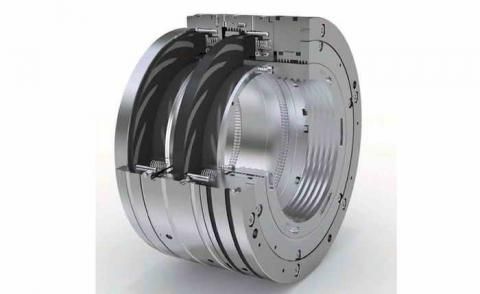Double seals vs tandem systems

Use double seals, with clean gas buffer systems if required, if sufficient N2 pressure is available and it is compatible with the process. This results in a less complex system of potentially higher reliability than tandem seals.
The reliability of any component is directly related to the complexity of its supporting systems. Double dry gas seals require the simplest system design. Double seals can be used for all process services that can tolerate N2 and have a seal reference pressure below 400 kPag (60psig).
If the process gas can contain debris and/or foul, a source of clean dry buffer gas is required to prevent seal hang up due to contamination of solid particles in the dynamic seal and spring system.
Double seals can help simplify the seal gas control system, minimize the quality of seal gas, and optimize system reliability. Double seals are normally applied where an inert seal gas (usually N2), which is compatible with the process, is available at a pressure exceeding the maximum process pressure at the seal interface (to prevent a seal pressure reversal). If N2 from a regulated system is used, the seal gas control valve can be eliminated.
If the process gas is sour, a sweet buffer gas must be injected between the process labyrinth, and DGS to prevent sour gas contact and potential DGS fouling. Differential pressure control is typically used. Flow control is also an acceptable option, provided the flow is sufficient to maintain a velocity of 15 m/sec (50 ft/sec) through the process labyrinth at twice the maximum design clearance.
Double dry gas seal systems, as compared to tandem systems eliminate the following items to reduce complexity and optimize reliability:
- Primary vent hardware and instrumentation
- Concerns with flare header pressures that can cause seal pressure reversals
- The intermediate N2 gas system
Lack of end user participation in the system specifications has resulted in the use of more complex tandem seal systems where double seal systems could be employed.
FAI has recommended double seal systems for new projects since 2000. Double gas seals have been used in low pressure coker and wet gas compressor applications.
Monitoring tandem seals
Monitoring both primary and secondary tandem seal conditions can ensure plant and personnel safety. Many tandem dry gas seal systems do not incorporate a means of monitoring the condition of the secondary (atmospheric) seal.
In addition, many applications do not include the injection of intermediate nitrogen between the primary and secondary seals. Not using intermediate nitrogen to buffer the seal chamber between the primary and secondary seal exposes the seal to a certain process gas release in the event of a secondary seal failure.
Methods to monitor secondary seal condition include:
- Monitoring high secondary vent pressure
- Monitoring low separation gas to secondary vent differential pressure
- Monitoring low primary vent pressure (where primary vent pressure is kept higher than flare header pressure by a backpressure device)
Failure to monitor the secondary tandem seal has resulted in safety issues (loss of plant assets and lost time accidents). This best practice has been used since 2005 after investigation of a secondary seal failure after a prolonged period on turning gear (compressor/steam turbine train in a chemical plant).
Since that time, it has been FAI standard practice to monitor secondary seal condition in all tandem seal applications.